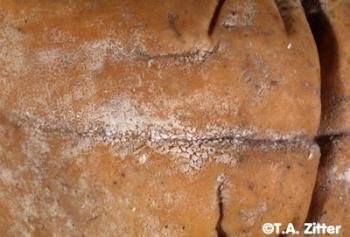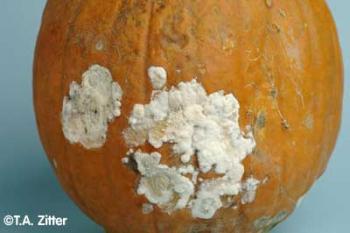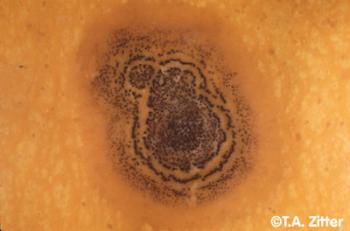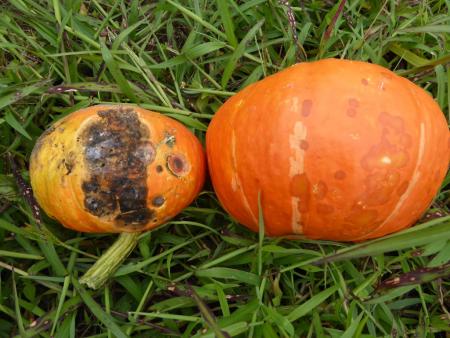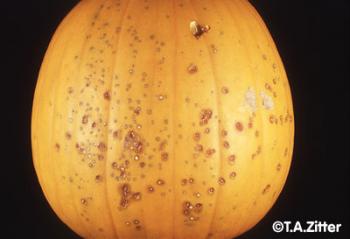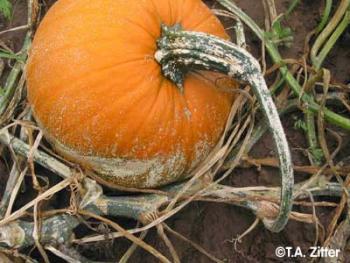Cucurbits, Fungal Fruit Rots
Many pathogens - fungi, bacteria, and viruses - can cause fruit rot, fruit spotting, and other fruit abnormalities in pumpkins that render them unmarketable. The vast majority of fruit rots are caused by the fungal organisms discussed in this article, although several bacteria (Xanthomonas campestris pv. cucurbitae and Pseudomonas syringae pv. lachrymans) can also cause fruit lesions and rots. In addition to the pathogens discussed below, other fungi that can cause fruit rots include Alternaria alternata (Alternaria Rot), Penicillium species (Blue Mold), Myrothecium roridum (Crater Rot), Pythium species (Pythium Cottony Leak), and Rhizopus stolonifera (Rhizopus Soft Rot). In general, a 2- to 3-year crop rotation is recommended where fruit rots have occurred, as the pathogens survive on crop residues in the soil. Many of them can also be seed-borne, so buy certified disease-free seed from reputable sources or use fungicide treated seed when possible. For other chemical recommendations please see the New England Vegetable Management Guide.
Phytophthora Fruit Rot (Phytophthora capsici)
For more detailed information on this disease, please see our full Cucurbits, Phytophthora Blight article.
Perhaps the most serious fruit rot in wet years, Phytophthora infection begins as a water-soaked or depressed spot, most often on fruit undersides which are in contact with the soil. The pathogen produces a white, yeast-like growth that contains many fruiting bodies (sporangia) and affected fruit may be completely covered. The disease can develop and spread rapidly with excessive moisture and temperatures between 80- 90°F. Entire fields may be destroyed. Phytophthora persists in the soil for many years; no effective crop rotation interval has been determined.
Management: Manage soil moisture by sub-soiling, avoiding over irrigating, selecting well-drained fields, and avoiding areas of fields that do not drain well. Destroying diseased areas at the start of an outbreak can be effective in reducing the spread of disease. Planting pumpkins into cover crop mulch or following the biofumigant cover crop ‘Caliente’ mustard has shown promise in research trials. Pumpkins with hard, gourd-like rinds are less susceptible to Phytophthora fruit blight. ‘Lil’ Ironsides’, ‘Apprentice,’ ‘IronMan,’ ‘Rockafellow,’ and ‘CannonBall’ have been reported as moderately-resistant. ‘IronMan,’ ‘CannonBall,’ and ‘Rockafellow’ also possess powdery mildew resistance. Newer oomycete-specific fungicides can be affective in reducing severity of Phytophthora blight in squash and other hosts such as peppers and tomatoes.
Fusarium Fruit Rot (Fusarium solani f.sp. cucurbitae)
For more detailed information on this disease, please see our full Cucurbits, Fusarium Fruit Rot article.
Pumpkin fruits are attacked by Fusarium at the soil line, and the severity of infection varies with soil moisture and the age of the rind when infection occurs. Surfaces of fruit that are in contact with the soil develop tan to brown, firm, dry and sunken lesions which may occur in concentric rings and remain firm unless invaded by secondary organisms. It can survive in seed but does not affect the germination or viability of the seed. Fusarium produces abundant resting spores (chlamydospores) in the soil, but only persists there for 2-3 years. Wounding is not necessary for infection to occur. Cultivars vary in their resistance with larger pumpkins being generally more susceptible.
Management: Culling of unmarketable fruit can reduce the risk of spread during the post-harvest period.
Black Rot (Didymella bryoniae)
For more detailed information about this disease, please see our full Cucurbits, Black Rot article.
Also called Gummy stem blight when it occurs on other plant parts, this disease produces a distinctive black decay. Initially, a brown to pink, water-soaked area develops in which numerous, black fruiting bodies are embedded. On butternut, symptoms may appear as a superficial, hardened, tan to white area which can develop concentric rings. Large Halloween pumpkins are more susceptible to black rot than smaller pie types. The pathogen is soil- and seed-borne and can overwinter in infected crop debris as dormant mycelium or chlamydospores. Wounding is not required for disease initiation, but wounding by striped cucumber beetles, aphid feeding, and powdery mildew infection all lead to increased susceptibility.
Management: Crop debris should be plowed under promptly after harvest. Control of powdery mildew can significantly reduce black rot infection of pumpkins. Avoid chilling injury to winter squash and pumpkins in storage as this activates dormant black rot lesions and increases losses in storage. Store fruit at 50-55°F and ~60% relative humidity.
Anthracnose (Colletotrichum orbiculare)
For more detailed information about this disease, please see our full Cucurbits, Anthracnose article.
Cucurbit anthracnose is common on the fruit and foliage of watermelons, squash, melons, and cucumbers in humid regions. Young fruit may turn black and die if their pedicels are infected, while older fruit develop circular, noticeably sunken, dark-green to black lesions which may exhibit a salmon colored exudate in moist weather. The pathogen is both seed- and soil-borne and can cause serious losses. Infected fruit may have a bitter or off-taste, in addition to lesions, and deteriorate quickly due to the invasion of secondary rot organisms. C. orbiculare survives between crops in infected crop debris, in volunteer plants, or weeds of the cucurbit family. The fungus does not require a wound to initiate infection and is spread by splashing water, workers, and tools in warm, humid weather.
Management: Collect and burn or plow down deeply infected crop debris after harvest. Avoid wounding fruit during harvest and immerse fruit in a solution of 120 ppm chlorine after harvest.
Scab (Cladosporium cucumerinum)
For more detailed information on this disease, please see our full Cucurbits, Scab article.
This pathogen attacks all parts of the plants, but is most serious because of the disfiguring scab lesions that develop on fruit. The disease is favored by heavy fog, heavy dews, light rains, and temperatures at or below 70˚F. The spores (conidia) are borne in long chains, are easily dislodged, and spread long distances on wind. On foliage, the first sign of the disease is pale-green, water-soaked lesions which turn gray and become angular. On fruit, spots first appear as small sunken areas which can be mistaken for insect injury. The spots may ooze a sticky liquid and become crater-like as they darken with age. Dark green, velvety layers of spores may appear in the cavities and secondary soft-rotting bacteria can invade. Severity of symptoms varies with the age of fruit when it becomes infected. C. cucumerinum overwinters in infected squash and pumpkin 4 vines, soil, and may also be seed-borne. Spores produced in the spring can infect in as little as 9 hours, produce spots by 3 days, and produce a new crop of spores by 4 days.
Management: Do not save your own seed if the disease is present. Select well-drained fields with good air circulation to promote rapid drying of foliage and fruit. During cool, wet weather fungicide sprays may not be entirely effective because of the rapid disease cycle.
Plectosporium Blight (Plectosporium tabacinum)
For more detailed information on this disease, please see our full Cucurbits, Plectosporium Blight article.
Like scab, Plectosporium blight is most damaging when it appears on the fruit. Pumpkins, yellow squash, and zucchini are the most susceptible. Lens to diamond shaped, white to tan, lesions occur on stems, leaf veins, petioles, peduncles, while fruit lesions are more rounded. Severe stem and petiole infections can result in death of leaves and defoliation. Infected stems are dry and brittle. On fruit, the pathogen causes white, tan, to silvery russeting; individual lesions can coalesce to form a continuous scabby layer. In wet years, which favor disease development and spread, crop losses in no-spray and low-spray fields can range from 50 to 100%. No resistant cultivar of pumpkins has been reported and it has not been reported to be seed borne.
Management of Fungal Fruit Rots
Start with disease-free seed or use fungicide-treated seed. Do not save your own seed if disease is present in the field. Select well-drained fields with good air circulation to promote rapid drying of foliage and fruit. Rotate out of cucurbits for 2 or more years. Fungicide sprays can reduce diseases which start in the foliage and then splash on the fruit e.g. Plectosporium, Scab, Anthracnose. Spraying copper can reduce infection of fruit by the foliar diseases angular leaf spot and bacterial leaf spot. Destroy and plow crop residues promptly after harvest to prevent their spreading and hasten their breakdown in the soil. Control of powdery mildew can significantly reduce black rot infection of pumpkins. Avoid chilling injury to winter squash and pumpkins in storage as this can allow for spread of some diseases in storage. Store fruit at 50-55°F and ~60% relative humidity.
The Center for Agriculture, Food and the Environment and UMass Extension are equal opportunity providers and employers, United States Department of Agriculture cooperating. Contact your local Extension office for information on disability accommodations. Contact the State Center Director’s Office if you have concerns related to discrimination, 413-545-4800 or see ag.umass.edu/civil-rights-information.

